|
|
| home > esposizioni |
| Display
Engineers Aaron Betsky |
||||
| The
Whitney Museum of American Art hosted, between March 1st and June 1st
2003, a significant restrospecive on the work of two among the most
provocative architects practicing today: Elizabeth Diller and Ricardo
Scofidio. Scanning: The Aberrant Architectures of Diller + Scofidio
is introduced, on the pages of ARCH'IT, through three presentations:
in "Installing Diller + Scofidio at the Whitney" Alicia
Imperiale focuses on the immersive and intense journey that D+S
lay out for the visitors of the exhibit; in "Display Engineers" Aaron
Betsky, co-curator of the show with K. Michael Hays, gives an insightful
investigation of D+S’s oeuvre; and finally there is a brief interview
to the architects conducted by Marco
Ligas Tosi. [PG] |
||||
| The
work of Diller + Scofidio is a form of display that removes from architecture
the idea that it is always and only about shelter, comfort, and functionality.
The principals in this collaboration, Elizabeth Diller and Ricardo Scofidio,
are hybrid architects/artists who make visible the technologies of desire
and reveal the surveillance of objects of desire. They reconstruct the
rituals of buying and selling, of control and negotiation that make
up a world that may be our daily reality, but that goes unnoticed. They
articulate the invisible into the all-too-apparent. In doing so, Diller
+ Scofidio construct an alternative to our culture of display,in which
the continual presentation of consumable goods —including human
beings— appears to be the central task of the social and economic
system. In short, these artists display display. In order for ourselves, our goods, and our information to work, they cannot merely have a presence; they must be designed to catch our attention, to seduce, to make sense in an ever more confusing environment. (1) Diller + Scofidio want to make us aware of this fact by heightening, questioning, or frustrating the act of display, and by doing this within display itself. They make art out of and in shopping, security, sexual role-playing, and a panoply of the other display-oriented activities we engage in every day. |
[29oct2003] | |||
| Display
is central to our culture. We display our goods in packaging, advertising,
and retail environments, we display ourselves in our clothes and through
our body language, and we display our information in signs and icons.
(2) More than in an "empire of signs," we live today in the realm of
display. (3) Without making judgments about whether there is a true
nature of things outside of appearances, or if our culture is becoming
more superficial, it is easy to observe the increased importance not
of how things appear to us, but how they are displayed. There is an
economic reason for this. Shopping, buying, and all the rituals that
go with them have displaced production as the pivot of economic and
cultural life. The regulation of those rituals —through a web of security
that extends through the visible and invisible surveillance cameras
mounted from factory floor to store, but also through the clerical acts
that make goods available at the right time and place— provides an invisible
structure beneath our slippery reality of surfaces. (4) |
NOTES: 1. Explanations of the centrality of display in our culture have generally come from the worlds of sociology and anthropology. The roots of display have been effectively sketched by Claude Levi-Strauss (see Myth and Meaning [New York: Schocken Books, 1995] and The Savage Mind [Chicago: University of Chicago Press, 1966]) and Clifford Geertz (see The Interpretation of Cultures [New York: Basic Books, 2000]). For a good survey of current thinking on the importance of display in our culture, see Lynne Cooke and Peter Wollen, eds., Visual Display: Culture Beyond Appearances (New York: The New Press, 1999). Display's effects in architecture have ranged from resistance to acceptance. For variations on these responses, see Ada Louise Huxtable, The Unreal America: Architecture and Illusion (New York: The New Press, 1997), and Ole Bouman and Roemer van Toorn, eds., The Invisible in Architecture (London: Academy Editions, 1994). 2. For a recent survey of the role of shopping in our culture, see Ann Satterthwaite, Going Shopping: Consumer Choices and Community Consequences (New Haven: Yale University Press, 2001). 3. The phrase is Roland Barthes's, who saw our culture as dominated by "empty signifiers." The book that carries the phrase as its title (The Empire of Signs, trans. Richard Howard [New York: Noonday Press, 1963]), however, addresses Japanese culture. For a more relevant collection of essays, see his The Fashion System, trans. Richard Howard (Berkeley: University of California Press, 1990). 4. See Thomas Hine, I Want That: How We All Became Shoppers (New York: HarperCollins, 2002). 5. Rem Koolhaas designed this store as part of an effort to formulate and codify a "scientific" approach to shopping. See his Projects for Prada (Milan: Fondazione Prada, 2001) and The Harvard Guide to Shopping (Cologne: Taschen, 2001). 6. I discussed the interdependency of art and retail through the reductive power of the brand or icon in Icons: Magnets of Meaning (San Francisco: San Francisco Museum of Modern Art, 1997). Two evocative discussions of this phenomenon are Mario Perniola, Enigmas: The Egyptian Moment in Society and Art, trans. Christopher Woodall (London: Verso, 1995), and Julian Stallabrass, Gargantua: Manufactured Mass Culture (London: Verso, 1996). 7. The phrase "experience economy" was coined at Harvard Business School in the mid-1990s and has made economists and politicians aware of something observers of architecture had noted long before: that "themed" environments and city centers have merged as attractors that give meaning to both consumer goods and the lives of consumers—for better or worse. See B. Joseph Pine, B. Joseph Pine II, and James H. Gilmore, The Experience Economy (Boston: Harvard Business School Press, 1999). For a critique of this phenomenon, see Michael Sorkin, Variations on a Theme Park: The New American City and the End of Public Space (New York: Hill & Wang, 1992). 8. For the rules that such engineers must follow, see Paco Underhill, Why We Buy:The Science of Shopping (New York: Simon & Schuster, 1999). 9. For the importance and functioning of ritual, see Levi-Strauss and Geertz, op. cit., as well as Levi-Strauss's The Origin of Table Manners, trans. John and Doreen Weightman (Chicago: University of Chicago Press, 1990). For ritual's social meaning in developing and developed cultures, see Pierre Bourdieu, The Field of Cultural Production, trans.Randal Johnson (New York: Columbia University Press, 1993). 10. Many critics would argue that such constructions are in fact impossible, and that we must instead make a strict distinction between what has grown historically and organically, and the meaningless and valueless places produced by capitalism (see Marc Augé, Non-Places: Introduction to an Anthropology of Supermodernity, trans. John Howe [London: Verso, 1995]). I think that this is a simplistic distinction and that the architect can and must find ways of deriving value from a place, however bare it may seem. 11. These are commonly accepted ways of judging architecture, starting from the simple observation that the discipline revolves around the making of buildings that are meant to house their occupants in a safe and comfortable manner. Such is the implicit message of the profession's educational, licensing, and code standards. 12. I would thus argue that Diller + Scofidio provide a way out of the choice between a resistance to modernity, capitalism, and the grinding aspects of commercial life, and a resistant, time- and place-bound architecture that would remove itself from the realities of modern life. 13. See RoseLee Goldberg's essay, "Dancing about Architecture," in Betsky, Hays, Anderson, Crandall, Dimendberg, Goldberg, Schafer, Scanning: the Aberrant Architectures of Diller + Scofidio, New York: Whitney Museum of American Art, 2003. 14. Such taste is defined by the social class to which both the architects and this author belong. See Pierre Bourdieu, Distinction:A Social Critique of the Judgement of Taste (Cambridge: Harvard University Press, 1984), and Herbert Gans, Popular Culture and High Culture: An Analysis and Evaluation of Taste (New York: Basic Books, 1999). 15. See Hyungmin Pai, The Portfolio and the Diagram: Architecture, Discourse, and Modernity in America (Cambridge: MIT Press, 2002). he critic Mark Wigley has also been researching the modes of taste and presentation in the culture of architecture and has expressed his ideas in lectures that this author has found very persuasive, but have not yet been published. 16. For a survey of the ways artists have looked at and used techniques of display, see Max Hollein and Christoph Grunenberg, eds., Shopping: A Century of Art and Consumer Culture (Frankfurt: Hatje Cantz, 2002). 17. I have described this movement as "dead tech" and "Home Depot modern." Its roots go all the way back to the work of architects such as Thomas Jefferson, who adopted and adapted English aesthetics and technologies to local conditions. 18. See David E. Nye, American Technological Sublime (Cambridge: MIT Press, 1996). 19. The firm, Berman, Roberts, and Scofidio, existed from 1967 to 1970. 20. For a definition of and discussion of the importance of collage, see John Elderfield, ed., Essays on Assemblage (New York: The Museum of Modern Art/Harry N. Abrams, 1992); Christine Poggi, In Defiance of Painting: Cubism, Futurism, and the Invention of Collage (New Haven: Yale University Press, 1993); and Thomas Brockelman, The Frame and the Mirror: On Collage and the Postmodern (Evanston, Illinois: Northwestern University Press, 2001). 21. Their approach to the art of the everyday is much more active than the one that has been popularized by such architects as Deborah Berke, which relies on mimicking existing structures and forms. See Steven Harris and Deborah Berke, eds., Architecture of the Everyday (New York: Princeton Architectural Press, 1997). 22. Diller + Scofidio have been working in this field longer than any other practitioners. See my Building Sex: Men, Women, Architecture, and the Construction of Sexuality (New York: William Morrow, 1995). 23. See Nan Ellin, ed., Architecture of Fear (New York: Princeton Architectural Press, 1997). Visuality and the importance of the gaze has been a standard part of the architectural discourse in recent years. A signal contribution connecting this theoretical discussion to technology is Graham MacPhee, The Architecture of the Visible: Technology and Urban Visual Culture (London: Continuum Books, 2002). 24. The notion of blur as an aesthetic quality, and as something that can be used to organize information, was researched at the MIT Visual Language Laboratory in 1992 and 1993, where it led to several advances in computer interface design. Diller + Scofidio say they have not been aware of this work. |
|||
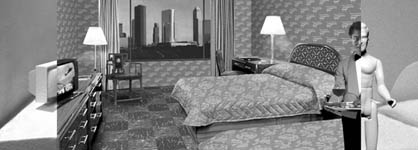 In the vast retail industry, where up to $50 million can be spent on the construction of one store (Rem Koolhaas's Prada Soho), both art and architecture have taken on the function of framing, stating, and representing the objects to be desired. (5) Thus the central task of the architect is no longer the construction of the central institutions of the state, as it had been from the moment the term was codified by the French Academy in the eighteenth century. Rather, it is the making of places for display: the display of power, of goods, of the art that validates, through its very unavailability, the culture of consumption. (6) |
||||
| This
culture of display allows the architect to maintain her or his role
as the designer of the central parts of our urban environments, since
our stores, restaurants, bars, theaters, and other places where display
takes place are the institutions around which our lives now revolve.
We come to cities more to have an experience —to see, to be seen, to
buy, to acquire well-packaged information— then we do to work or live.
(7) To remain relevant, then, the architect must concern her- or himself
with the spaces where this occurs. The other functions the architect
has, such as organizing space, figuring out how to construct buildings,
and orchestrating complex material choices, can now be done more efficiently
by engineers of various sorts. What these specialists, each of them
concerned above all else with reducing costs, cannot do, however, is
what "wasteful" architects, trained to care about appearances and staging,
are still good at: manipulating space, light, proportion, and material
so that we, our goods, and our data can be displayed. So it is the architect
who sets the scene for the rituals of buying and selling, defines the
sequence of events, controls the flow of people and goods, and contains
acts of desire in coherent frameworks. The architect has become an engineer
of display. (8) |
||||
| Diller
+ Scofidio concern themselves with the ways display functions to present
a consumable reality. Their work also asks the question of where and
how the architect must define her- or himself in this task. They answer
this by turning display back into ritual art, and by making art out
of our daily rituals. In so doing, they find a new way to attach value
to the objects of architecture (or art) itself. In primitive cultures,
the derived value of things, the value not inherent in an object itself,
was stored in icons of religious devotion or in objects representing
the wealth of those in power. The surplus of meaning and wealth these
objects contained was preserved through acts of power and devotion —staged
in temples, palaces, and other tombs— meant to make real the invisible
value of things, including that of human life. (9) In our culture, this
surplus is so dispersed and so pervasive that we no longer notice it.
Value now exists everywhere we turn —in the excess of consumer goods
through which we define ourselves, in the artificial heroes and heroines
whose images we desire, in the miniature palaces we want our homes to
be, and in the temples of consumption where we shop. (10) |
||||
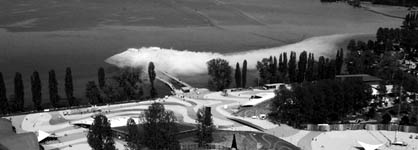 Diller + Scofidio thus operate differently than traditional organizers of space and materials. They refuse to accept the myth that art and architecture are simply the production of functional elements. They do not start from the premise that the aim of architecture should be the production of an object that houses a defined function and that behaves in a responsible fashion. They are not concerned, at least not primarily, in modulating environmental inputs to produce an efficient and sensible place to live, work, or play. And they do not make the way in which the building continues or contributes to the context in which it appears the focal point of their design activities. (11) These architects/artists also do not offer escape or direct criticism—they do not make art that shows us the image of a world more perfect than our own, nor do they present direct commentary on our reality. Their work is not consumable bits of cultural commentary that lives on white walls or on museum pedestals. Rather, it has the character of art as a concentrated form of value, the form of architecture, and the function of providing a self-conscious form of display. |
||||
| This
confusion of modes of making is central to Diller + Scofidio's oeuvre.
Their work is also no longer "unique," in the sense of stating itself
as either of one time or place or as an object of desire. In other words,
they do not make "critical" objects that in their strange appearance
or novelty are meant to offer alternatives to our current reality. They
also do not try to perfect prevalent styles, as do some architects working
in "neoclassical" or "neo-modern" modes. Instead, they map and mirror
the rituals of display, from going shopping to eating in a restaurant
to attending a state fair, then frustrate those mechanisms of seduction
and packaging. Diller + Scofidio's work seeks to surf on our culture
of display, and then to frustrate its smooth workings. (12) |
||||
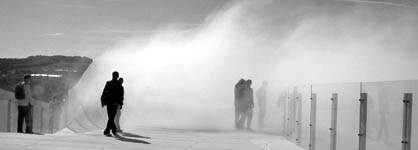 Still, Liz Diller and Ric Scofidio are both architects, and thus have inherited the anxiety about the role of the architect. When they started their joint practice in 1979, however, they were part of a New York milieu in which questions of display were central. Because of their affiliation with the Cooper Union School of Architecture and with the New York art scene, and because they began to work together during a period when making buildings was difficult for purely economic reasons, they were completely wrapped up in three basic issues: taste, technology, and organization. |
||||
| During
this era, Diller + Scofidio started to use the techniques they found
in performance, site-specific art, and Pop art to make an architecture
that was exactly about those issues. (13) They made work that played
on the accepted norms of good taste. They used technological innovations,
but at a scale and in a way that denied its inherent logic.Rather than
smoothly functional buildings, they made performances, installations,
and exhibition displays that worked within existing buildings and their
conventions, changing how they appeared through the display of an alternative
set of images, bodies, and signs. |
||||
| While
these were the basic questions Diller + Scofidio were addressing, they
were also exploring a series of themes, including domesticity, rituals
of daily life, security and surveillance, gender roles, and prosthetics.
Today, after some twenty years of working, their themes and many of
their techniques have begun to merge in work that has, above all else,
the quality of blur, or of limbo. Diller + Scofidio make mechanisms
of display in which sharpness and clarity disappear (blur), and which
leave us uncertain how to interpret what should be seductively displayed
phenomena (limbo). These qualities represent a final criticism of productive
society and a statement of the singularity of what it is the architect/artist
does. The resulting work is almost like an anti-building. To start with the techniques: Diller + Scofidio have exquisite taste. (14) They pose themselves very carefully within an aesthetic that is fashionable yet recognizable, as it is built on historical and popular images. To work, this tastefulness has to be new-seeming, elegant, and still slightly disturbing. This may sound like a negative thing to those trained to think that the balancing act between the new and the familiar is the sign of somebody who is not a "true" artist. But if we are willing to admit that a person who makes images, objects, and spaces that we think of as art or architecture does so in a way that is part of a wider culture, we have two choices: We either have to believe that the artist or architect is doing so unconsciously, or that they are doing so in a self-conscious and even ironic manner. 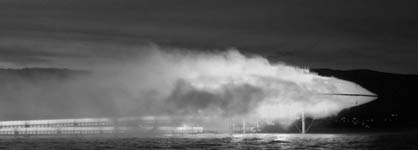 Whether unconsciously or ironically, Diller + Scofidio evidence great taste. The objects they make have a seemingly effortless grace and appropriateness that we do not have a proper critical language to assess. We (or at least this author) experience the work as beautiful, and are therefore willing to accept what it does. The sources for this beauty seem to lie in a combination of standard architectural representational techniques, such as section drawings, perspectives, and finely wrought models. |
||||
| It
also extends into the craft of making both buildings and objects, where
Diller + Scofidio employ the kinds of details architects are fond of
using to accentuate the salient elements of their buildings. Generating
this sensibility are, at least in part, the color, compositional, and
other formal techniques taught at art and architecture schools. (15) One might think of the result of all this as the aesthetics of display itself. (16) Diller + Scofidio engage in a kind of meta-display, integrating the methods by which things are presented with the presentation objects themselves. Their exquisite line drawings, the giant lips on a video screen (in Soft Sell), the carefully constructed scaffolding for monitors (in almost all of their works), and the glasses seen in the case (Vice/Virtue Glasses), are all part of the same construction. It is almost impossible to separate out what is the fetish and what is the ritualistic element that surrounds that object of desire. They give such objects a highly controlled and integrated framework that itself becomes an object of desire. |
||||
| Diller
+ Scofidio have also become masters of innovative technology, scavenging
hardware and electronics stores to find the latest devices to activate
their work. This is a very American attitude toward technology; they
work in a culture that includes not only Frank Lloyd Wright, Buckminster
Fuller, and "dead tech" designers such as Eric Moss and Morphosis, but
also the tinkering mechanics that produced the automotive and movie
industries, to name just a few examples. (17) The basic components of
Diller + Scofidio's work are thus not found in architects' standard
catalogues. Rather than follow traditional modes of construction, they
turn to a manner of assembly that might be common in a workshop or on
a movie set. This gives their work a sense of temporary rightness. All
the pieces have been assembled for a highly specific purpose; they function
for precisely the length of time needed. Like a scene's set or a store,
they are temporary mechanisms of display. But it is display itself that
is on show. This care taken with the display of various technological gadgets makes Diller + Scofidio's work appear at first glance as if it consists of highly individual pieces that have no all-encompassing form. Elements often float in space, as either objects or as images, without an immediately clear ordering principle. The presence of so many switches, screens, and miscellaneous pieces of hardware often threatens to usurp the overall design. Their work has also included, almost from the beginning, electronic components that produce images and sounds as if by magic. As a result, their oeuvre has a quality Americans are familiar with from The Wizard of Oz: the hidden technology that transforms or controls the world is revealed, and at the same time reveled in. (18) There is also a sense of mystery about their work that recedes as the viewer lifts more and more of the veil that surrounds its inner workings. It is not surprising, then, that Diller + Scofidio's first major public art work, Delay in Glass (aka The Rotary Notary and His Hot Plate; 1987), was a restating of Marcel Duchamp's Large Glass (aka The Bride Stripped Bare by Her Bachelors, Even), in which the technology stripping the bride became visible, then reversed itself. |
||||
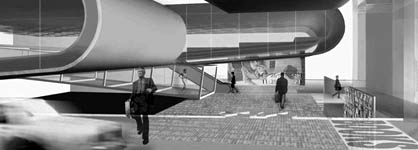 The third technique Diller + Scofidio use is the efficient organization of their production processes. In their work, they act as organizers of resources into coherent objects, places, and images. While this is the quality that makes their work successful, it is also the most difficult one to grasp. Architects have long claimed that they were orchestrators, coordinators, or conductors, wrangling into coherence the disparate elements that make up a building. Today, however, this self-image is usually reserved for those who lead larger architectural offices. The avant-garde architect instead often revels in the "artist" image, struggling in a studio with limited resources, making things that always come too late and don't always perform as advertised. Diller + Scofidio have some of these qualities, as they worked in a small loft in New York, were always running late on deadlines, and projected an image of being artists who could not be bothered with the bureaucratic structures of commissioning. Yet Scofidio had run a large architecture office before starting Diller + Scofidio, and both he and Diller are highly adept at organizing their projects and highly controlling of the final results. (19) Unlike some of their avant-garde contemporaries, they have produced work that can actually be seen, inhabited, and experienced. That might sound like faint praise, but it is of signal importance; one easy definition of Diller + Scofidio is that they are artists who get things built. What is built, however, often has the exact quality of an orchestration, rather than of a building, as in the choreography of their dance works, the assembly of pieces in their American Lawn: Surface of Everyday Life and Tourisms: suitCase Studies installations, and the timing of the images on the lenticular screens of Travelogues, an installation at John F. Kennedy International Airport. |
||||
| The
dance of thoughtfully assembled bits and pieces of technology in an
elegant manner serves as a good, if reductive, definition of Diller
+ Scofidio's work. But the work is also resolutely about something,
and that is display itself. The problem with this as a subject is that
it —or its derivatives and counterpoints, such as desire and security—
is so inherent in any objects made as either art or architecture that
it becomes difficult to discern. So display as a subject is something
Diller + Scofidio have worked out in or through a number of different
themes. The first of these themes is the nature of domesticity, which initially emerged in their 1987 installation The withDrawing Room, at the Capp Street Project in San Francisco. This theme uses as its basic elements the props of everyday life: beds (sawn in half and rotating), chairs (with mirrors inserted in their middle), tables (hanging right below the ceiling), and what the French call meubles, or movables, such as towels (for Him and Her, in one installation). Each of these objects is recognizable, but no longer usable in the way it was originally designed to be. |
||||
There
are several things that make this theme of domesticity important. First,
it is also an aesthetic technique—the assembly or elements taken from
everyday life, placed within a frame, and made no longer legible or
usable. It is, in effect, assemblage or collage. In this way the theme
asks the question of how we can use or understand the most basic elements
of the modern world. (20) Second, instead of theoretical questions about
the nature of humanity in a modern age, Diller + Scofidio have concerned
themselves with the basic things that we use every day. They address
the much more essential issue of what it means to have a human body,
and how that body behaves in social relations when the implements it
uses are inherited or mass-produced. They often pose these questions
through objects that we can—or exactly can't—sit on (the unusable chairs
in Para-site), or gather around (a table we can't reach, in The
withDrawing Room), or see (a mirror that stands where we want
to sit, in Vanity Chair). Such unusability gives their work an
immediacy; it also makes it part of the world around us in a way many
Pop artists aspired to, but which they often found difficult to achieve
because of their work's status as "high art." (21)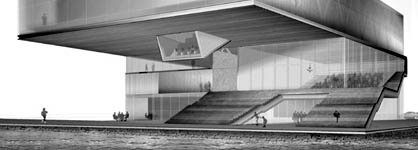 Diller + Scofidio's focus on domesticity has expanded to include the design of living environments. (One of these, a 105-unit apartment building in Gifu, Japan, has actually been constructed.) The architects/artists are always most interested in what one sees and uses in the house or apartment, however, instead of in the enclosure of (or for) moments of domesticity. The apartment block in Gifu is a curving assembly of small cells that are assembled in a stepped plan; there is no stable floor plan, and no simple facade. The individual apartments appear as indistinguishable elements that never cohere into a whole. This is true of apartment buildings in general, but here the contradiction between mass production and the need for individual homes people can identify as their own is made evident. |
||||
| The
Slow House, an unrealized project for a vacation home on Long
Island, is a machine for viewing. This would seem an appropriate function
for a beach-side second home, but Diller + Scofidio again push the issue
to the extent that the view takes over completely, defining the building's
shape and producing a window that is completely out of scale with the
house's other attributes. Moreover, the view is duplicated on a monitor,
which plays a recorded version of the scene, so even the authenticity
of that to which all the house's functions genuflect is questionable.
Nowhere does the Slow House become a home in the traditional sense of
the word. The notion of ritual is not just implicit in Diller + Scofidio's mechanisms of display, it has also become a theme. It has been expressed mainly in their theater work, but it is also present in the way elements are arranged and used in their installations, permanent and otherwise. The ritual of swinging the bed in The withDrawing Room, for example, becomes the abstracted dance of measuring sticks in Moving Target. The ironing of Bad Press is as much the point of the piece as the deformed clothes that result from these actions. The murder mystery in Indigestion is just an excuse to work through the intricacies of negotiated financial and sexual relations. The rituals in Diller + Scofidio's work often mimic mass production, as in the robots endlessly rotating in the installation Master/Slave. Here the architects/artists are indicating that a large part of our daily actions are not our own, but are dictated either by the norms of our society or by the need to be productive. Their art consists of making us aware of such rituals by perverting them, structuring them so they have a logic that is believable, productive, and yet profoundly disturbing. |
||||
Much
of Diller + Scofidio's recent work exists as performance or as documentation
in time-based media. Their collaboration with several gifted choreographers,
for example, has led to a number of elaborate performance pieces. They
have also organized a loose troupe of performers who are able to bring
their work quite literally to life, as in the video piece that accompanies
the Blur Building in Yverdon-les-Bains, Switzerland. Rather than acting
as conductors or choreographers through architecture, they have taken
on that task directly. They have become engineers of display. To experience these works, however, one has to either be present or give one's self over to the ritual that is so central to our culture, watching television. By abstracting this activity—such as in Soft Sell, where a pair of lips asks if you want to buy various goods, both tangible and intangible, like a parody of a television commercial—and perverting its purpose, Diller + Scofidio have, like other video artists, turned the tables on the mass media. Unlike most of the work in this emerging field, however, their time-based work is made as objects (installations) that have their own presence. The craft of assembling the various components of these installations ties the work to everyday reality, while the architects/artists' refusal to make an enduring, all-encompassing object echoes their theme of domesticity by stating the importance of effect. Two other themes in Diller + Scofidio's work, gender and prosthetics, give it a dramatic engine. The way in which our society stereotypes women has been a central concern to Diller + Scofidio since at least their 1987 Delay in Glass performance. To a certain extent this theme is autobiographical, as it traces Diller's emergence as a partner in the firm and her struggle to define herself as an architect in a profession that has usually assigned women to interior design or craft. It has also been a way for Scofidio to move away from the traditional role of the master architect in which he was trained and had worked. The pair uses the methods that have been reserved for women, such as the organization of domestic elements, in combination with the technological tricks for which male architects are famous, to make perverse reversals of gender roles. (22) |
||||
Diller
+ Scofidio did not stop, as other artists and critics have, at stating
the artificiality of gender role assignments. Rather, their work has
made it clear that there is a more general problem in defining both
what the body is and what our reality as bodies is. The architects/artists
do not just reveal (and toy with) the idea that we have erected a fantastically
elaborate system of acting out particular functions based on the properties
of the body. They also make clear that we manipulate the body itself.
We don't just play roles as men and women, but also as workers, viewers,
critics, rulers, etc. The way we extend our body in order to do this
becomes a harness or straitjacket that eventually imprisons us.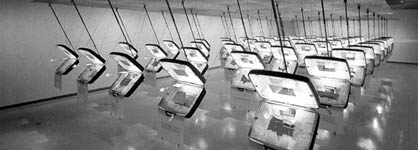 Diller + Scofidio have used many elements one might call prosthetic, especially in their early work. It is in these pieces that display and control come together; through prosthetics we both internalize the world around us and extend our bodies and the technologies they have assimilated out into the world. Prosthetic elements stand in for our arms, our legs, and our eyes. They bring perverse actions beyond what our bodies are capable of into the realm of possibility. The cameras, chairs, and other metal ganglia of Para-site, their 1989 MOMA Projects Room installation, summed up many of these ideas, bringing the body of the museum and that of the visitor together into a kind of spatial robot that stood in for both. The robots that circulated around the Fondation Cartier a decade later in the Master/Slave installation echoed these concerns. Encapsulating memory into concrete aides memoire such as the suitCases is another way the architects/ artists have extended the body's ability to control space and time. Again, Diller + Scofidio do not talk about the alienation of labor, but merely show us to be puppets manipulated by strings, reveal our limbs to be levers meant for work, and make visible the invisible ways in which we subject the world to our gaze in order to evaluate and use it. This last concern, of the gaze, has taken on more significance in Diller + Scofidio's recent work, to the extent that surveillance is now what critics most identify as their signature subject or style. Surveillance was the central theme in Para-site, the installation that first brought them to wider public attention, and it is an element that runs through almost all of their current designs. We are always being watched while we desire what is displayed; our ability to think and act freely is always running up against the controlling actions of an authority of surveillance. (23) All that remains of the controlling and organizing functions architecture used to have are little cameras and sensors and the responses they generate—sometimes with force, sometimes, say, with more air forced into a building as more occupants enter. Diller + Scofidio lavish their greatest care and attention on this last redoubt of control. |
||||
| They
have also developed a defense mechanism against surveillance in recent
years: the effect of blur. Starting with their use of the "snow" of
an untuned television in the installation Non-Place, and with
the limbo spaces of airplane travel they later explored in Jet Lag,
Diller + Scofidio have concentrated on the undefined. It is almost as
if they are reacting against their own desire to control and produce
recognizable images, places, and objects by creating works in which
one is never quite certain what one is seeing. (24) By making objects that have no presence other than as mutable, ephemeral, or indistinct images, but_then become spatial and environmental effects, Diller + Scofidio seem to be moving beyond a practice that has tried to rethink architecture's concerns in terms of the techniques of art to produce instead a form of critical display. Domesticity, gender roles, rituals, and prosthetics are less important in their recent work than the delight in the confusion of edges, spaces, and messages that occurs when technology is used against itself. Stories are broken off or impossible to understand, as in Travelogues at JFK; lips speak no longer with insistent messages but in an unintelligible language in the entrance to the Blur Building. Display is being directly denied.  Ironically, in shifting their mode of working Diller + Scofidio began making things that look more like buildings. Indeed, they have long wanted to prove that they are architects, albeit on their own terms, and that means making buildings. If the structures they produce are a little strange-seeming, at least to those who don't think of clouds as a proper place of habitation, or who like their buildings with beginnings and ends, that does not make them any less buildings. The danger in these new works, however, is that Diller + Scofidio will reduce themselves to the production of more fashionably innovative buildings. In time they may become monuments to the firm's achievements, and thus the artfully decorated tombs of their architectural ambitions. I, for one, am not overly worried about this. In fact, Diller + Scofidio have already moved on to their next set of concerns, which seem to be coalescing around the nature of display as subject matter. Their ambition is to use the techniques of blur to make constructions in which one is never quite sure what one is experiencing, where one is, or how one should behave. The codes of behavior that tell us what to want and what to buy no longer work, as we don't know what we are meant to do. But other codes are hard at work, crunching away inside Diller + Scofidio's computers, creating always different effects. Beautiful uncertainty, hovering at the moment of desire, when one doesn't know whether to buy or admire, to be disgusted or delighted, to think of architecture or give one's self over to art, will result. It is at this moment that the freedom both of the maker and of the viewer, who keeps her- or himself alive by always deferring the fulfillment of the aim of display and desire, becomes completely and sublimely apparent. Aaron Betsky |
||||
| "Display Engineers" first appeared in: Betsky, Hays, Anderson, Crandall, Dimendberg, Goldberg, Schafer, Scanning: the Aberrant Architectures of Diller + Scofidio, New York: Whitney Museum of American Art, 2003, pp23-36. Permission to reprint Aaron Betsky's text was granted by The Whitney Museum of American Art, NYC. | ||||
| ARCH'IT
books suggests: Betsky, Hays, Anderson, Crandall, Dimendberg, Goldberg, Schafer "Scanning: the Aberrant Architectures of Diller + Scofidio" Whitney Museum of American Art, New York, 2003 pp244, $45.00 buy online and save! |
| >
IMPERIALE: INSTALLING: DILLER+SCOFIDIO AT THE WHITNEY > LIGAS TOSI: INTERVISTA A DILLER+SCOFIDIO |
||||
|
Per
qualsiasi comunicazione laboratorio
|